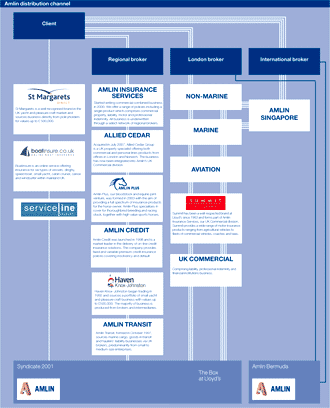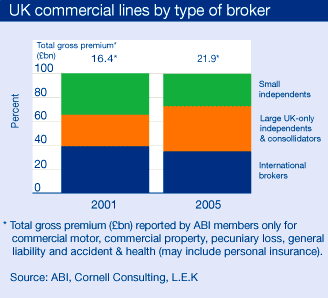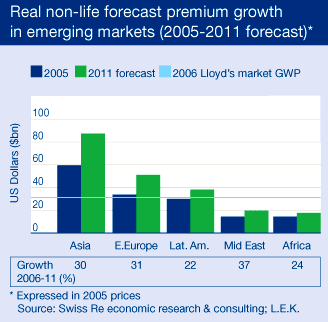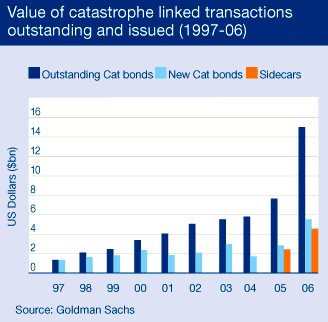Review
Clients – understanding and responding to their needs
Our distribution channels
The following flowchart shows the different distribution channels used by our businesses.
Amlin distribution channels

Click here for full sized image
Amlin accepts commercial business from Lloyd’s brokers, regional brokers, managing general agents via binding authorities and a small amount of personal lines business on a direct basis.
The relationships are varied and subject to varying competitive pressures. However a common thread is the pressure for change, albeit to varying degrees, across the distribution chain. The causes of pressure are varied but require Amlin to be flexible in its approach to meeting brokers’ needs.
To understand the changes it is necessary to split our markets into three distinct categories; the UK insurance market, the global speciality insurance market and the reinsurance market.
In the UK, the pace of retail broker consolidation has been extraordinary. Consolidation dynamics originate from consolidators of brokers into networks, such as Towergate. Greater control over distribution has given the larger, emerging groups market power over traditional insurance carriers, pressurising margins. Subsequently we have witnessed insurance carriers buying material stakes in independent brokers to defend their position. Much of this activity has been in mainstream insurance, away from our specialist markets. However, it is inevitably putting greater pressure on wholesale brokers introducing business to the London market.

Amlin is well respected and recognised as a leader in its markets. For UK commercial insurance we have historically focused on commercial motor and liability insurance. For retail insurance we have a strong franchise in yacht and bloodstock insurance. Using these strengths we have begun to improve our local engagement with regional brokers and to adopt a more clearly defined sales and marketing approach. A strategic aim for the UK Commercial business is to increase its commercial property account into the next hardening insurance cycle in the UK. Consequently, in July 2007, we acquired Allied Cedar Group, with the aim of expanding our UK property account, developing new SME business and selected new niche personal lines property products.
Affecting our global speciality lines, we are seeing the emergence of stronger local markets which are being developed to service increased local needs resulting from strong economic growth. This provides both a risk to the flow of business into London as well as an opportunity to use Amlin’s expertise to capture new business overseas.

Singapore has been a good example of this development, with the Singaporean authorities, determined to develop Singapore as an Asian insurance hub. In November, we opened our Singapore office operating as part of the Lloyd’s Asia platform which allows risks sourced by our Singapore office to be carried by our Lloyd’s syndicate in London, a very efficient means of operating. Amlin Singapore will provide regional clients, many of whom would not take their business to the London market, with coverage in marine energy, cargo, property and terrorism business. However , we expect that the larger and more complex risks will continue to be underwritten in London.
The reinsurance market has seen continual structural change over recent years, first with the emergence of the Bermudian markets and latterly with the pick up in capital markets activity. Fundamental to these changes has been the desire for investors to marry up capital and risk more efficiently.
The traditional response of investment markets to opportunities in reinsurance markets, typically arising due to capital depletion following a catastrophic event or series of events, has been to invest permanent capital in the industry. This was evident in the initial start up of Bermudian companies in the 1980s in response to a lack of available capacity for casualty insurance and reinsurance. Similarly, following the 11 September terrorist attacks a number of new reinsurance companies were set up to provide property catastrophe cover. However the hurricane events of 2005 exposed the mismatch of risk and capital within many of these companies, largely due to the lack of diversification of perils written.
While a number of new companies were set up post 2005, capital market investment has begun to take a structurally different and less permanent form. There are many possible routes to transfer catastrophe insurance risk to capital markets including pure financial instruments (catastrophe bonds, industry loss warranties and catastrophe swaps) or hybrid instruments which require an insurer, such as the so called sidecar.
We believe that a key structural trend in the reinsurance market will be further convergence with the capital markets. The graph above shows the growth in value of catastrophe linked transactions.

To date, capital markets products have not provided protection to clients at a level which we believe would materially reduce demand for our traditional reinsurance products. However, we are maintaining a close watch on developments.
